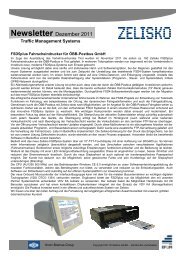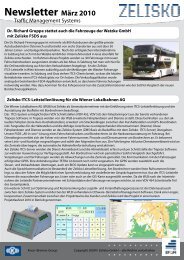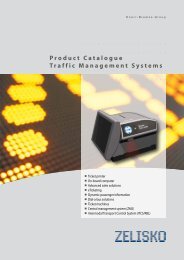Annual Report 2012 - Knorr-Bremse AG.
Annual Report 2012 - Knorr-Bremse AG.
Annual Report 2012 - Knorr-Bremse AG.
Create successful ePaper yourself
Turn your PDF publications into a flip-book with our unique Google optimized e-Paper software.
28<br />
Research and development<br />
As a technology group, <strong>Knorr</strong>-<strong>Bremse</strong> continued to drive<br />
forward its research and development efforts in the year<br />
under review in close collaboration with its customers. Total<br />
expenditure on research and development and project<br />
planning amounted to EUR 249.7 million in <strong>2012</strong> (2011:<br />
EUR 208.8 million), which equates to 5.8% (2011: 4.9%) of<br />
consolidated sales.<br />
As the global technology leader in the fields of braking<br />
systems for rail and commercial vehicles, <strong>Knorr</strong>-<strong>Bremse</strong><br />
develops innovative products distinguished by their safety,<br />
high quality, reliability and customer benefits. This applies<br />
in equal measure to the other fields covered by the<br />
product portfolios of the Rail Vehicle Systems division (automatic<br />
door systems, air-conditioning and driver assistance<br />
systems, control components and platform screen<br />
doors) and the Commercial Vehicle Systems division (driver<br />
assistance systems, torsional vibration dampers and<br />
other powertrain-related components, such as PBS and<br />
transmission control systems).<br />
<strong>Knorr</strong>-<strong>Bremse</strong>’s market success with these products is<br />
founded on its comprehensive command of electronics,<br />
pneumatics, and mechanical engineering. These capabilities<br />
enable the company to provide its customers with<br />
complete braking systems. The long-standing trend toward<br />
the introduction of innovative system solutions and<br />
modular solutions involving the increasing use of mechatronic<br />
systems is continuing, which gives <strong>Knorr</strong>-<strong>Bremse</strong> a<br />
competitive edge in the marketplace. In <strong>2012</strong> the Group<br />
continued to pursue its ambition of realizing innovative<br />
solutions that meet local market and customer requirements,<br />
and of continuously improving these solutions in<br />
the interests of its customers, as evidenced by an impressive<br />
number of innovations and awards.<br />
2008 171<br />
2009 153<br />
2010 175<br />
2011 209<br />
<strong>2012</strong> 250<br />
Consolidated research and development expenditure in EUR millions<br />
In <strong>2012</strong>, research activities in the rail vehicle sector focused<br />
among other things on the development of innovative<br />
products for the BRIC states as well as for Middle<br />
Eastern countries. Thus, for example, the KAB60 control<br />
valve for Russia and the CIS states that had been inspected<br />
and approved in 2011 was integrated into a complete<br />
braking system − including controls − for customer<br />
Alstom Transportation. In the development process, the<br />
components were prepared to meet the special demands<br />
of operating temperatures as low as minus 50°C.<br />
The systems are destined for use in twin-unit freight locomotives<br />
belonging to Kazakh operator Kazakhstan<br />
Temir Zholy, the first application in a rail market governed<br />
by the GOST standard. Other significant new developments<br />
included a noise-encapsulated oil-free compressor<br />
to reduce noise during low-speed braking, and<br />
an exceptionally flat HVAC unit from <strong>Knorr</strong>-<strong>Bremse</strong> subsidiary<br />
Merak that takes account of the very restricted<br />
installation space in metro cars and also excels through<br />
its low noise level and ease of maintenance.<br />
In the commercial vehicle sector, development activities in<br />
the year under review focused – as in the previous year –<br />
on the next-generation ABS, EBS and ESP systems and on<br />
the further enhancement of the electronically controlled<br />
air treatment system (EAC2). Among the development<br />
projects brought to a successful conclusion in <strong>2012</strong> were<br />
TEBS G2.2 for truck trailers for customer Schmitz Cargobull,<br />
as well as EBS7 and EAC2.5 for Volvo. Moreover, a new generation<br />
of video cameras for driver assistance systems was<br />
developed together with <strong>Knorr</strong>-<strong>Bremse</strong>’s US subsidiary<br />
Bendix. The new cameras are to be introduced on the European<br />
market to provide a more robust and compact<br />
lane-keeping functionality at lower cost.<br />
In line with <strong>Knorr</strong>-<strong>Bremse</strong>’s regional strategy, in <strong>2012</strong> the<br />
proportion of the Group’s development capacity located in<br />
emerging markets such as India and China was further increased.<br />
In India, for example, the <strong>Knorr</strong>-<strong>Bremse</strong> Technology<br />
Center India (TCI) was founded which, as a joint venture<br />
between the two divisions, will provide development services<br />
for the Group. In total, the number of employees in<br />
the field of research, development and project planning<br />
worldwide showed a slight rise over the previous year.



![1 Newsletter 2013 Version 0 92 [Kompatibilitätsmodus] - Zelisko](https://img.yumpu.com/50939577/1/184x260/1-newsletter-2013-version-0-92-kompatibilitaatsmodus-zelisko.jpg?quality=85)




![Backofficelösung ZMS [PDF, 740 kB] - Zelisko](https://img.yumpu.com/33964695/1/184x260/backofficelaasung-zms-pdf-740-kb-zelisko.jpg?quality=85)

![Geschäftsbericht 2012 [PDF, 13 MB] - Zelisko](https://img.yumpu.com/31517535/1/184x260/geschaaftsbericht-2012-pdf-13-mb-zelisko.jpg?quality=85)


![Produktkatalog Gesamtlösungen [PDF, 4 MB] - Zelisko](https://img.yumpu.com/22973479/1/182x260/produktkatalog-gesamtlaasungen-pdf-4-mb-zelisko.jpg?quality=85)
![ITCS Datenblatt [PDF, 804 kB] - Zelisko](https://img.yumpu.com/22855155/1/184x260/itcs-datenblatt-pdf-804-kb-zelisko.jpg?quality=85)
![Fahrscheindrucker FSD5plus [PDF, 934 kB] - Zelisko](https://img.yumpu.com/22822643/1/184x260/fahrscheindrucker-fsd5plus-pdf-934-kb-zelisko.jpg?quality=85)
